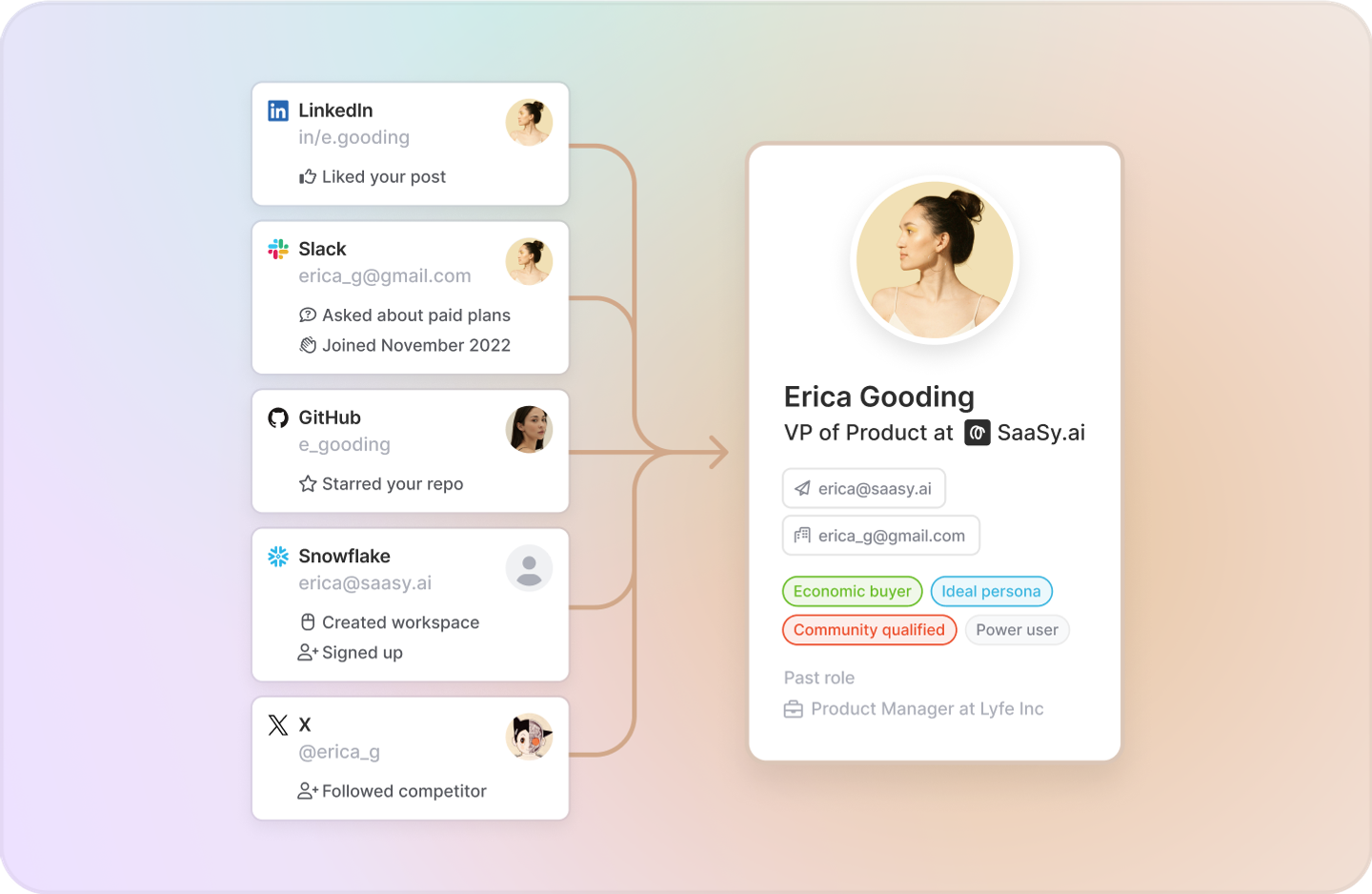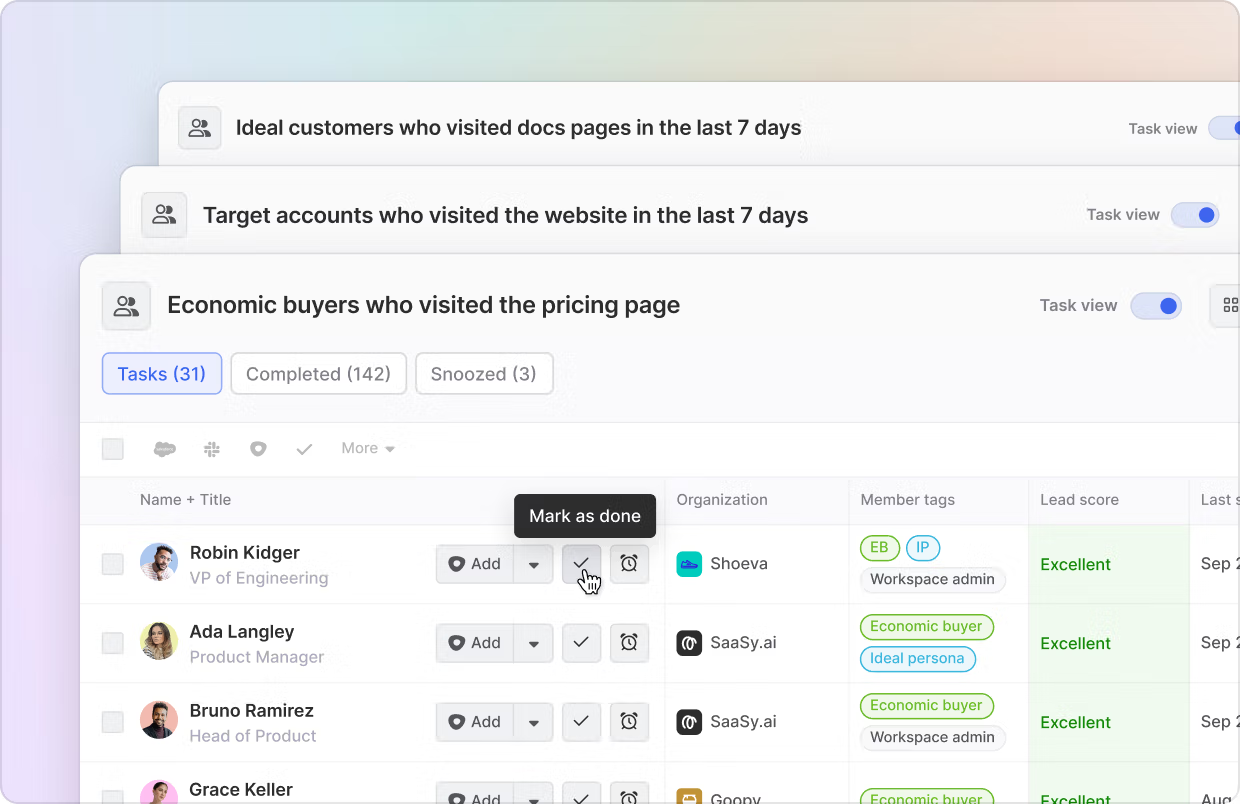
How dbt Labs centralized buying signals to increase speed to lead
“Common Room makes me a hell of a lot more efficient. I have a lot of AEs to support, and I need to deliver pipeline for them. Common Room is a big part of that. I can book meetings much more quickly.”

Aaron Munro
Sales and Business Development Leader, EMEA
Business model
- Open-source
- Sales-led
- Enterprise
Teams
- SDRs
Use cases
- Unified customer view
- Account-based sales
- Job-change tracking
- GTM workbench
- Workflow automation
Key signals
- Summary
- Key quotes
- Background
- Unify and enrich buying signals
- Separate buyers from browsers
- Accelerate speed to lead
- Results
Turn buyer intelligence into pipeline with AI.
Book a demoAbout dbt Labs
dbt Labs pioneered the practice of analytics engineering and built dbt—the primary tool in the analytics engineering toolbox. dbt is the standard for data transformation and is used by more than 40,000 companies around the world.
Problem
dbt Labs’ SDRs were looking for a more efficient way to tie all intent signals together in order to create more value-based messaging for prospects. Separating buying intent from interest in dbt Labs’ open-source product required manual, time-consuming research across multiple data sources. Without access to all relevant buying signals in one place—and a person-level view of the people behind them—sales efficiency suffered.
Solution
dbt Labs introduced Common Room to its SDR team to help reps capture and unify all buying signals, get full visibility into high-fit contacts and accounts, and support their inbound and outbound sales motions.
Strategy
dbt Labs uses digital signal capture and unified identity and account intelligence to centralize cross-channel activity in one place and provide GTM teams with person- and account-level context for prospects, allowing reps to consistently deliver value-based messaging depending on where accounts and contacts are in their dbt journey. Reps use AI-powered automations to stay updated and take action on buying signals across digital channels.
Results
Common Room generated:
- Dozens of hours in time savings across the SDR team
- Significant increases in pipeline opportunities
- Measurable improvements in sales efficiency

“Part of our outbound motion is looking for signals. From there, we can go into Common Room, look up that exact account, and then get a better picture of all the different ways they might be engaging with us. Who they are and what they’re struggling with. Common Room really helps us understand the account better.”

Caroline Wyse
Sales Development Manager

“Common Room is crucial to finding out who’s showing intent within accounts and generating pipeline.”

Aaron Munro
Sales and Business Development Leader, EMEA

“The value of Common Room for me is getting to pipeline faster. I can see the people who are engaged in accounts rather than searching through LinkedIn and looking at profiles and all that. I can find the right stakeholders and see how they’ve interacted with us in the past, which gives me another avenue to find people quicker and book meetings quicker.”

Aaron Munro
Sales and Business Development Leader, EMEA
Background
Unifying signals from every stage of the customer lifecycle gives go-to-market teams the context they need to work smarter, not harder.
Data-driven organizations like dbt Labs know this. That’s why they make sure their SDRs have the insights they need to spend less time searching and more time selling.
Here’s how dbt Labs used Common Room to:
- Centralize siloed buying signals
- Boost inbound and outbound efficiency
- Generate high-quality sales pipeline faster
Unify and enrich buying signals
dbt Labs has two distinct products: dbt Core and dbt Cloud.
dbt Core is open-source and free to use. Over the years it’s helped dbt become data professionals’ go-to solution for defining, executing, testing, and describing transformations in data platforms.
dbt Cloud is the company’s commercial offering. It’s a turnkey platform that makes it easy to use and deploy analytics code at scale using software development best practices to create production-grade analytics pipelines.
While the popularity of dbt Core fueled awareness of dbt and generated inbound leads curious about dbt Cloud, it also made it difficult for sales reps to distinguish between intent from high-fit buyers and interest from open-source users.
SDRs would tab back and forth between siloed data sources to try to piece together a view of contacts and accounts, qualify for fit, and uncover decision-makers. Sales efficiency suffered.
“We were digging through a bunch of Salesforce reports,” said Sales Development Manager Caroline Wyse. “We would look at a list of closed-lost opportunities, previous trials, people who attended a webinar—anything to try to paint the picture.”
Now dbt Labs uses Common Room to capture and unify buying signals across all its first-, second-, and third-party data sources, including Salesforce, LinkedIn, and many more.
IntegrationsCommon Room’s integrations with dozens of data sources—including popular digital channels, CRMs, data warehouses, sales engagement platforms, and more—allow you to organize and access all your data in one place. This makes it easy to take action on buying signals fast.
With help from Common Room’s AI-powered identity resolution and enrichment engine, Person360™, reps can quickly learn more about the people and organizations showing buying intent across digital touchpoints.
Machine learning algorithms automatically serve up contact details, job history, firmographic fit, and cross-channel engagements related to every contact and account active in dbt Labs' digital ecosystem.

Common Room’s Person360 feature allows you to automatically collect, deanonymize, enrich, and match signals to a unified profile for individuals and organizations. This makes it easy to connect with the people and companies behind buying signals with full context.
Reps can surface buying signals automatically and quickly qualify prospects.
“I can just pull up a profile and see who’s an economic buyer or a manager, which is really handy,” said Aaron Munro, Sales and Business Development Leader, EMEA. “I can see their contact info. And if I want, I can pull up accounts for an entire region and see who the most engaged ones are, filtered by employee size.”
Just as importantly, reps can quickly get context for a prospect’s buying journey.
“Common Room has really given us a much better scope into individual accounts and the pains that they're feeling,” Caroline said.
Separate buyers from browsers
dbt Labs’ SDRs split their days between fielding inbound leads and running outbound plays. Common Room helps with both.
Access to a 360-degree view of inbound leads makes it easy to research accounts and craft personalized, relevant messaging. And with full visibility into business-relevant activity across channels, SDRs can surface hand-raisers they may have otherwise missed.
“Last quarter, Common Room showed me someone asking about pricing,” said Aaron Munro, Sales and Business Development Leader, EMEA. “So I called him and walked through the points he’d brought up in his post. He was very receptive and wanted to have a conversation about it. That deal closed in two weeks.”
Meanwhile, on the outbound side, Common Room puts a wealth of buying signals at reps’ fingertips, from social engagements to job changes to news events to job listings and beyond. Reps can filter contacts and accounts across virtually any dimension, such as job title, organization size, annual revenue, and more.
FiltersCommon Room’s filters feature allows you to highlight individuals and organizations based on any combination of factors. This makes it easy to surface specific people and companies based on firmographic details, cross-channel activities, product usage, and more.
Even better, Common Room helps SDRs zero in on the right stakeholders at target accounts. Automated tags let reps spotlight economic buyers, ideal personas, and other key contacts on autopilot.

Common Room’s tags feature allows you to automatically label individuals and organizations with specific tags based on customizable criteria. This makes it easy to quickly filter for ideal personas, ideal customer profiles, and more.
“Part of our outbound motion is looking for signals,” Caroline said. “From there, we can go into Common Room, look up that exact account, and then get a better picture of all the different ways they might be engaging with us. Who they are and what they’re struggling with. Common Room really helps us understand the account better.”
Accelerate speed to lead
Whether inbound or outbound, the goal for dbt Labs’ SDRs is to move quickly.
Since Common Room centralizes all relevant information, the team has eliminated the need to manually dig through other tools to research and prioritize leads.
“Common Room makes me a hell of a lot more efficient,” Aaron said. “I have a lot of AEs to support, and I need to deliver pipeline for them. Common Room is a big part of that. I can book meetings much more quickly.”
Fully customizable alerts allow reps to stay notified of buyer activity in real time.
Team alertsCommon Room’s team alerts feature allows you to automate alerts based on any combination of triggers and filters so you can see real-time activity from the people and accounts you care about. This makes it easy to always stay updated on specific individuals and organizations.
Meanwhile, segments provide reps with auto-populating burndown lists where contacts and accounts can be added automatically based on preselected criteria.

Common Room’s segments feature allows you to automatically add individuals or organizations to auto-replenishing lists based on customizable criteria. This makes it easy to quickly surface, monitor, and engage specific people and companies at scale.
“Common Room is crucial to finding out who’s showing intent within accounts and generating pipeline,” Aaron said.
Results
Common Room helps dbt Labs’ SDRs go from signal to send much more quickly.
“The value of Common Room for me is getting to pipeline faster,” Aaron said. “I can see the people who are engaged in accounts rather than searching through LinkedIn and looking at profiles and all that. I can find the right stakeholders and see how they’ve interacted with us in the past, which gives me another avenue to find people quicker and book meetings quicker.”
dbt Labs helps its customers transform their data into powerful business insights. Common Room helps dbt Labs transform buying signals into fresh pipeline.
Tap into every buying signal with with Common Room
Get started for free or get in touch to see how Common Room can help you build stronger customer relationships and get to pipeline faster.
We think you'd like these
How Semgrep warmed up cold outbound to grow pipeline 74% in a single quarter
74% increase in pipeline
See how Semgrep used Common Room to increase qualified pipeline by 74% in a single quarter.Read full storyHow Zapier unified buying signals to increase meetings booked by 31% in 3 months
31% more meetings in 3 mos
See how Zapier used Common Room to increase meetings booked by 31% in 3 months.Read full storyHow Notion unlocked customer intelligence to generate 30% more meetings per rep per month
30% more meetings per rep
See how Notion used Common Room to generate 30% more meetings per rep per month.Read full storyHow CelerData optimized its GTM motion to drive a 75% increase in signal-sourced pipeline
See how CelerData used Common Room to drive a 75% increase in signal-sourced pipeline.Read full storyHow Pulumi revealed the buyers behind the signals to generate 27% of meetings booked
27% of meetings booked
See how Pulumi used Common Room to generate 27% of meetings booked.Read full storyHow Apollo GraphQL tapped into unseen signals to drive 26% of qualified leads
26% of qualified leads
See how Apollo GraphQL used Common Room to drive 26% of qualified leads.Read full story
